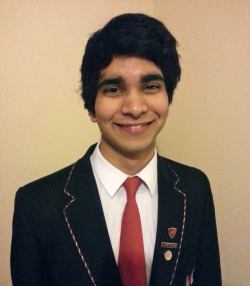8 January 2013
Omar's work with CAHID sees him nominated for prestigious award

A project he carried out at the University of Dundee has won a sixth-year pupil from the city's Menzieshill High School a place in the final of the prestigious National Science + Engineering Competition.
Omar Asad (18) was awarded a Nuffield scholarship to work with Dr Clare Lamb in the University's internationally renowned Centre for Anatomy and Human Identification (CAHID) to examine the factors responsible for the flexibility and suppleness in Thiel-embalmed cadavers.
The Thiel method of embalming gives surgeons, dentists, students and medical researchers a more realistic method of testing techniques, practising procedures and developing new equipment and approaches. CAHID is leading the way in the use of Thiel and is building a new morgue to fully realise its potential.
Omar helped Dr Lamb and the team further their knowledge of the biochemistry underpinning the technique by discovering that a fragmentation of muscle fibres enables Thiel cadavers to retain lifelike properties.
His is one of 200 research projects from young scientists aged 11-18 that will be showcased to an audience of around 65,000 during the Big Bang Fair in London from 14-17 March. In all, 30 awards with a prize fund totalling £50,000 and the titles of UK Young Engineer of the Year and Young Scientist of the Year are up for grabs.
Omar, who already has Highers in Biology, Chemistry and Physics, has applied to study anatomy at the University. He says he is delighted to have been nominated for the final of the competition, and that the experience of working at CAHID will stand him in good stead for his future studies.
"I was already planning a career in science, but this has made me doubly sure that this is what I wanted to do and that anatomy was the area I wanted to study," he said.
"It has also given me more confidence to pursue a career in science and I learned a lot from everyone at the University. I was given the opportunity through the Nuffield Foundation and was offered the choice of three projects. As I've applied to study anatomy this seemed the most relevant as well as the most interesting, so I asked to work with CAHID and I'm delighted I did.
"The aim of the project was to evaluate the unique lifelike properties of bodies embalmed using the Thiel method. We compared samples from Thiel cadavers with those using formalin, the traditional embalming fluid. What we found was that the difference was down to a fragmentation of muscle fibres that didn't occur in formalin cadavers.
"I'm really looking forward to going down to London in March and finding out how I get on in the final. I was hoping for the best when I submitted my entry but I knew this was a very unique project so that made me more confident of being selected for the final."
The National Science + Engineering Competition is open to all 11-18 year olds living in the UK and in full-time education. The Competition aims to recognise and reward young people's achievements in all areas of science, technology, engineering and mathematics (STEM).
The Competition is open for entries from January to October each year, through regional heats and online applications. From the thousands of original entries, 200 finalists are invited to showcase their work to thousands of people at The Big Bang Fair in March.
Jon Fitzmaurice, National Science + Engineering Project Manager, said, "We would like to congratulate all the projects that have made it through to the national finals. It is a great achievement and we have had thousands of outstanding entries that represent the very best of science and engineering in the UK."
Professor Sue Black, Director of CAHID, congratulated Omar on his nomination, saying, "Omar's research project will certainly raise some eyebrows. He was a pleasure to work with over the summer and the results of his project will help us to gain a much better understanding of the biochemistry of the Thiel embalming process."
Notes to editors:
CAHID is an internationally-leading centre in the fields of human identification, forensic anthropology, Disaster Victim Identification, cranio-facial reconstruction and the study of the human body.
Professor Black and other members of the CAHID team featured in the major BBC2 series 'History Cold Case'. The CAHID team have developed groundbreaking techniques in areas such as hand identification, which has directly led to the successful prosecution of a number of paedophiles identified from images of their hands found in obscene photographs and films.
The University of Dundee has launched the 'Million For A Morgue' campaign to support a new morgue which will allow Professor Sue Black and colleagues in the Centre for Anatomy and Human Identification (CAHID) to adopt the revolutionary Thiel method of embalming.
The University has already committed £1million to the project but another £1million needs to be raised.
For more on the Million For A Morgue campaign see: www.million4amorgue.com.
For media enquiries contact:
Grant Hill
Press Officer
University of Dundee
Nethergate, Dundee, DD1 4HN
TEL: 01382 384768
E-MAIL: g.hill@dundee.ac.uk
MOBILE: 07854 953277 |

